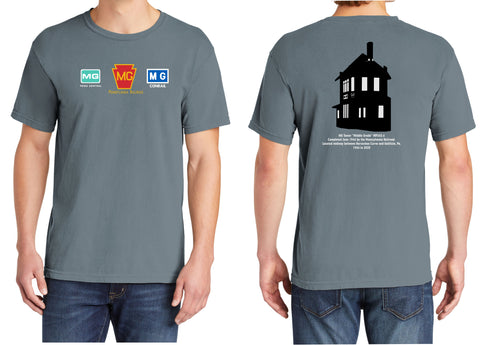
Santa Fe Super Chief Logo Hoodie
Santa Fe Super Chief Logo Hoodie
- 9-ounce, 50/50 cotton/poly fleece, Port & Company PC90H
- Printed Front Only
- Color Dark Heather Grey
The Super Chief was one of the named passenger trains and the flagship of the Atchison, Topeka and Santa Fe Railway. It claimed to be "The Train of the Stars" because of the various celebrities it carried between Chicago, Illinois, and Los Angeles, California.
The Super Chief (Nos. 17 and 18) was the first Diesel-powered, all-Pullman sleeping car train in America, and it eclipsed the Chief as Santa Fe's standard bearer. The extra-fare ($10) Super Chief left Dearborn Station in Chicago for its first trip on May 12, 1936. Before starting scheduled service in May 1937, the lightweight version of the Super Chief ran 2,227 miles (3,584 km) from Los Angeles over recently upgraded tracks in 36 hours and 49 minutes, averaging 60 mph (97 km/h) overall and reaching 100 mph (160 km/h).
With one set of equipment, the train initially operated once a week from both Chicago and Los Angeles. After more cars had been delivered the Super Chief ran twice weekly beginning in 1938 and daily after 1948. Adding to the train's mystique were its gourmet meals and Hollywood clientele.
Competitors to the Super Chief were the City of Los Angeles on the Chicago and North Western Railway and the Union Pacific Railroad, and (to a lesser extent) the Golden State on the Rock Island and Southern Pacific. The Santa Fe Super Chief was one of the last passenger trains in the United States to carry an all-Pullman consist; only the Pennsylvania Railroad's Broadway Limited and the Illinois Central's Panama Limited survived longer. The train maintained its high level of service until the end of Santa Fe passenger operations on May 1, 1971.
When Amtrak took over operation of the nation's passenger service on May 1, 1971, the 35-year run of the Super Chief on the Santa Fe ended, though Amtrak used the name on the same route for three years. In 1974 the Santa Fe withdrew permission to use the name due to a perceived decline in service, so Amtrak renamed it Southwest Limited. Following the delivery of new Superliner equipment, the Santa Fe allowed Amtrak to call it the Southwest Chief in 1984.
*Image is a representation and may not be exact




